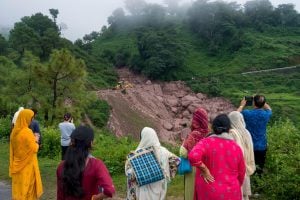The Himalayan region, with unresolved border disputes involving Afghanistan, Pakistan, India, China and Bhutan has seen extensive deployment of military personnel and related infrastructure.
According to the UNEP, the environment “continues to be the silent victim of armed conflicts worldwide”. This is particularly evident on the Tibetan plateau, where escalating tensions over the Line of Actual Control (LAC) between India and China have had severe consequences.
After a clash between Indian and Chinese troops in June 2020 in the Galwan Valley, India deployed over 68,000 troops, 330 infantry vehicles and more than 90 tanks. Large-scale infrastructure projects have also been built including bridges, roads and helipads.
Things are less clear on the Chinese side, but one report claimed that, along with a large deployment of border-defence companies, the People’s Liberation Army (PLA) has also mobilised additional conventional combat forces.
Understandably, this heavy military presence has raised fears of a future conflict, but less remarked upon are the severe effects these changes are already having on people and environment.
Stripped of land, severed from cultural networks
There is little information about what is happening on the Chinese side of the disputed eastern region (called Arunachal Pradesh by India and contested by China). Villagers in West Kameng district have fiercely protested the destruction of over 80% of a 36 sq km sacred forest by the Border Roads Organisations (BRO) without prior consultation, to make way for a road. This community-managed forest was home to the endangered red panda.
Similarly, the people of Dolyngmukh in Kamle district staged a large protest, demanding the Indian Air Force base move its practice bombing zone, alleging that indiscriminate bombing had killed livestock, destroyed vegetation and injured villagers. Social activist Bini Ranjan described the practice as “war-like” and that locals feared for their lives.
It is not as if the Indian government is unaware of the environmental impact of such practices. The Wildlife Institute of India conducted an environmental assessment of the Mandal Thang Field Firing Range in Ladakh, on the western side of the LAC, just last year. Despite acknowledging the strategic significance of the site, it noted that ammunition waste had made the land dangerous for humans and animals, contaminating the water. It recommended environmental awareness training programmes for military officers in response. Despite these findings, the National Board for Wildlife approved several projects in the Changthang and Karakoram wildlife sanctuaries in Ladakh, in November 2023, without undertaking any environmental assessments, including diverting 1,259.25 hectares of land from the Changthang wildlife sanctuary for the Mahe Field Firing Range, to bolster defence infrastructure near the LAC.
The very presence of personnel and equipment in such an ecologically fragile area present challenges of their own. A March 2022 article identified heavy vehicular pollution as a key contributor to black carbon, which accelerates the melting of Himalayan glaciers. Sonam Wangchuck, a Ladakhi environmentalist, said “the Indian side alone emits approximately 300,000 tons of CO2 annually, considering the substantial amount of fuel transported and burned for military operations”, with Chinese emissions “slightly higher” and Pakistani emissions slightly lower. Combined, he said, there were nearly 1 million tons of CO2 being released in the region.
Although it is harder to assess what is happening on the Chinese side, large-scale deployment and military exercises also likely impact the region’s ecology. For instance, in August 2021, the PLA Tibet Military Command conducted joint exercises at an altitude of 4,700 metres, firing thousands of munitions, including mortar shells, rifles, grenades and rockets and involved dozens of tanks and infantry fighting vehicles.
Communities caught in between these militarised Himalayan zones have historically enjoyed free flow of trade and cultural exchange. But in the post-colonial era, the Indigenous people of these lands – the rightful owners of the land and its resources – have become a source of friction between India and China.
The Changpa community has been prevented from accessing its traditional grazing grounds in the west of the LAC. The Mishmi tribal community in the east has lost cultural ties with their sub-group on the other side of the LAC since 1962.
Diplomatic efforts offer hope
Yet, hope remains. Biodiversity protection could help curb militarisation and its damaging effects on people and wildlife. In April 2023, China adopted the Qinghai-Tibet Plateau Ecological Protection Law, promoting conservation and protection of the plateau.
Similarly, in India, the Supreme Court passed an interim order in February 2024 regarding the Forest (Conservation) Amendment Act, 2023, which initially excluded forests “situated within 100 km of international borders or LAC from protection. While the final order is pending, the court has urged the government to pay attention to all forests.
These incremental legal steps could mitigate the ecological degradation caused by militarisation and help reduce tensions. Ecosystem services specialist, Sunita Chaudhary, from the International Centre for Integrated Mountain Development (ICIMOD) declared recently that ecological decline in the Himalayas is “so advanced and accelerating so fast they now pose a threat to the lives of not just animals and plant life, but also human societies”. Maharaj K Pandit, a scholar of Himalayan ecology, argues that “Diplomacy is their only hope”.
Even the demilitarised zone between North and South Korea has become a unique nature sanctuary.Opangmeren Jamir
Establishing transboundary conservation areas holds promising prospects, as the border landscape between India and China is one of the world’s most biodiverse, hosting four of the 36 global biodiversity hotspots. Evidence shows that transboundary conservation areas can lead to better biodiversity conservation, improved ecosystem services and the promotion of international peace and cooperation.
While this may sound radical, India and China have precedent for such cooperation. In September 1993, the two countries signed a bilateral agreement on the environment during the then Indian Prime Minister PV Narashimha Rao’s visit to Beijing.
Other tense border regions have also successfully implemented transboundary protected areas, including the Condor-Kutuku Peace Park, between Ecuador and Peru despite their own decades-long border dispute. Another example is the Kgalagadi Transfrontier Park between South Africa and Botswana, founded in 2000. Even the demilitarised zone between North and South Korea has become a unique nature sanctuary.
In an interview with Newsweek, Indian Prime Minister Narendra Modi said “Stable and peaceful relations between India and China are important not just for our two countries but the entire region and world.” He added “that through positive and constructive bilateral engagement at the diplomatic and military levels, we will be able to restore and sustain peace and tranquillity in our borders.” Reacting to the Prime Minister’s statement, China said: “We hope that India will work with China…and seek to handle differences appropriately to put the relationship on a sound and stable track.”
These recent reciprocal and positive gestures raise hopes that preserving biodiversity in the Himalayas will become a diplomatic priority for India and China, potentially leading to a more peaceful and ecologically stable region.










